
Honda CBR250R vs KTM Duke 200 vs Bajaj Pulsar 200NS: Comparison
- Nov 22, 2012
- Views : 569277

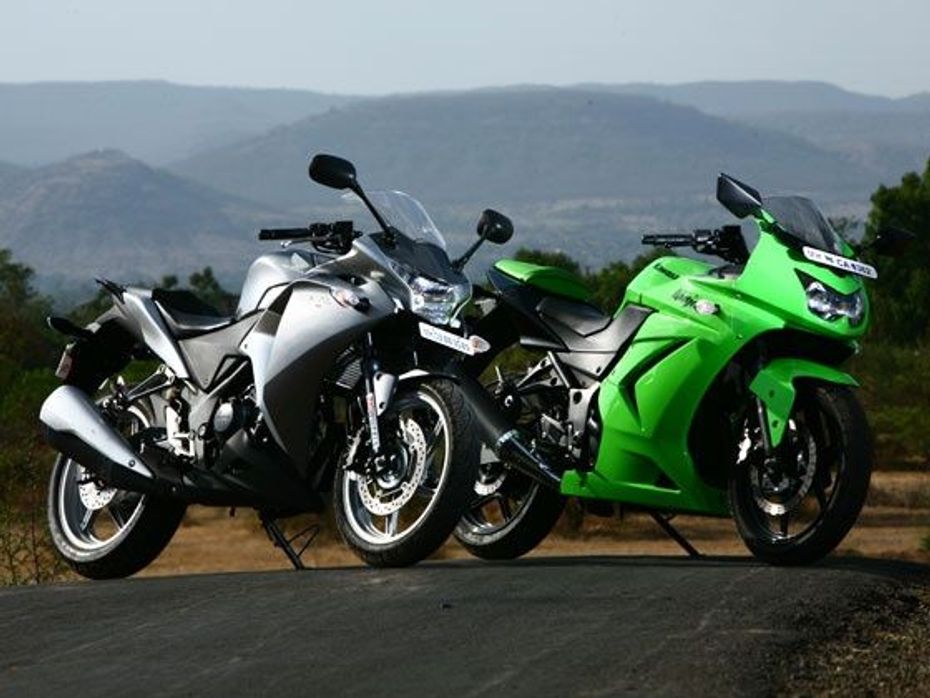
Now before we get into the battle of these quarter-litre motorcycles, let’s delve a bit deeper into the popular 250cc segment and find out why the Kawasaki Ninja 250R or previously known as the GPZ-250R until 2007 has ruled this class of bikes since it first turned a wheel back in 1983. Essentially there were two chief reasons that significantly helped the Ninja to remain on top of the game for over two decades – lack of a sporty-looking yet comfortable 250cc sports model and the global focus shifting to high capacity sport models in search of impressive lap times, almost ignoring the average road user.
This made the baby Ninja’s position even stronger in the global motorcycle market as it remained unchallenged through the ages with regular fresh updates to the engine as well as the design. The likes of the Suzuki GSX-R750 and Honda’s CBR900RR Fireblade changed the rules of the motorcycle world in the nineties and that was the era when the super-light and ultra-fast superbikes were born. With all the other motorcycle manufacturers vying for top honours in the supersports (600cc) and the superbike (1000cc) classes, the lower-end of the spectrum was totally ignored. Those who wanted to go up the motorcycling ranks gradually (and might I add, sensibly) but without having to compromise for a rather dull looking street-spec 250, for them the Kawasaki Ninja 250R was an absolute no-brainer.
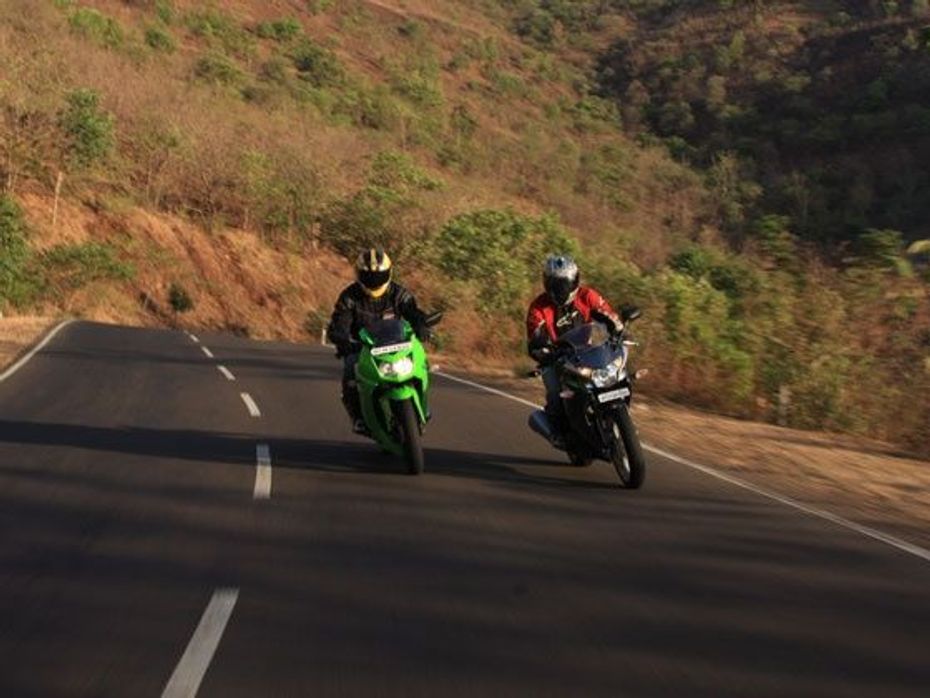
Push forward to 2011 and the motorcycle industry is waking up to the importance of street-users than only focusing on trackday-goers. The recent global economic slowdown has made it difficult for many to pursue their passion for two-wheels and the obvious as well as the cheapest option is to take it to the street – a little less safe and less fun then, but for an average Joe rider it is certainly more attainable without having to disrupt the monthly budget to fit in a trackday or two. With such a seismic shift in the market trends, it is obvious that the companies will now hunt for a more street-worthy tool than a track scorcher. And when it comes to the streets, a 250cc machine is just the right thing especially for our Indian roads where any of the superbikes make very little sense and there aren’t too many affordable street-friendly middleweights on sale either, yet.
This was reason enough for us to pit two of the current quarter-litre motorcycles in the market, the veteran Kawasaki Ninja 250R which has enjoyed a strong following for over two decades the world over against the spunky young Honda CBR250R, which brings some really exciting technologies to the street like Anti-lock Braking System (ABS) at a phenomenal price advantage that the Ninja cannot match up to. So will the baby-CBR bring an end to the legend of the Ninja or will the Ninja continue its reign? The results are surprising.
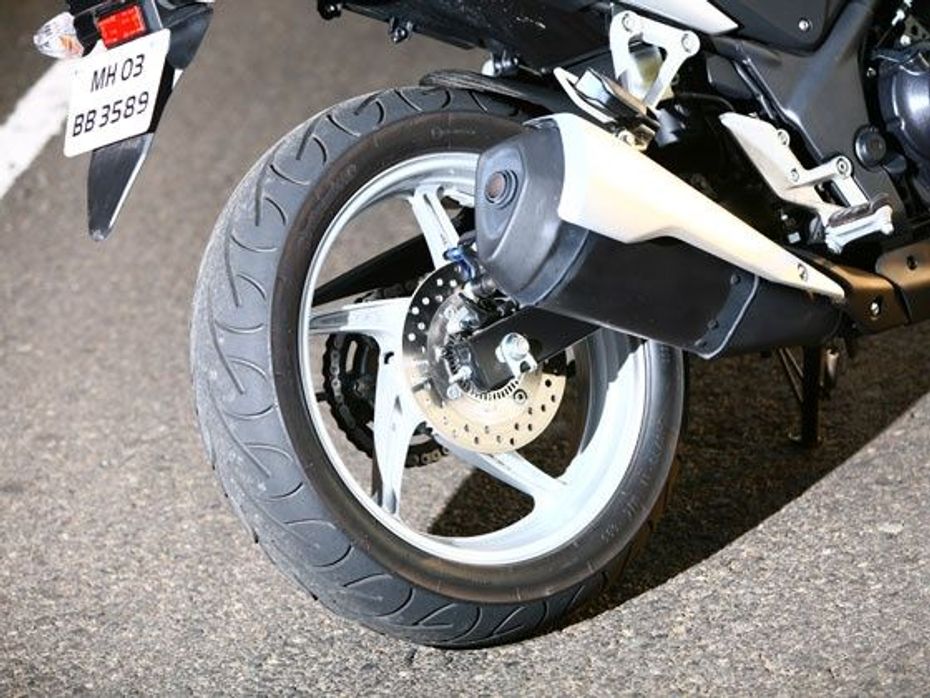
Round One
Let’s take a look at the new CBR’s design, which is largely borrowed from the big Honda VFR1200F with its chunky front fairing and curvy lines. Honestly, it’s a bit bland from the front, but the CBR certainly has one of the best looking rear-ends in the business. The Ninja on the other hand does not break any new records in styling but still carries a big-bike feel along with its sporty appeal of a middleweight supersport. The Kawasaki is roomier and feels plusher than the Honda, while the CBR is compact and easier to ride thanks to its 5kg deficit over the Ninja and shorter wheelbase. The size and weight difference amongst the two quarter-litre pocket rockets is instantly noticeable and the Ninja definitely feels also bigger one out of the two.
For the street it is important that the ergonomics and seating is comfy for daily use as well as hard-riding and both the bikes do a fantastic job at it. Ninja’s roominess and bigger windscreen make it a worthy long distance tourer but the CBR’s small dimensions and light-weight physique make it that more manageable in the city limits for everyday commute. City is where most of the Indian bikers will ply in and keeping that in mind, the CBR definitely is a better suited product for a larger audience. The Ninja is for the elite motorcyclist who will get on the saddle to enjoy the open roads than commute to work in style. There is nothing wrong with either of the choices – to each, his own. In simpler words, a city biker looking for a 250 will be happier with the seating on the CBR while the long distance rider or the weekend sport-rider will find the ergonomics on the Ninja that much suited.

Round Two
On paper, the two bikes might not be very closely matched with the Ninja 250R clearly outshining the CBR20R with its twin cylinder engine layout, 33PS of power output (7PS more than the CBR) and a solid top whack of 160km/h plus. But take them to the streets and the CBR250R lives upto to Honda’s traditional engineering prowess and is quite up there with the old geezer Ninja. The 0-100km/h times on both the bikes are quite closely matched with the Ninja clocking 8.1 seconds while the CBR lacking not too far behind with a 0-100km/h time of 8.6 seconds. Although there is marginally extra torque on the CBR250R – 23.8Nm as against the Ninja’s 22Nm, the Ninja still manages to outrun the Honda in the in-gear acceleration test with the green mean machine taking just 10.9 seconds in the 30-70km/h dash in sixth gear while the Honda clocking 11.5 seconds for the same test.
So on the streets in real world Indian road conditions, both the bikes are quite evenly matched and the only real place where the Ninja outdoes the CBR convincingly is in the top-end performance with an impressive top whack of over 165km/h while the CBR only managing about 152km/h. Both the bikes possess good grunt to cruise at about 100km/h but the CBR definitely feels like its doing more work there than the Ninja which doesn’t feel like its running out of breath till about the speedometer needle touches the 160km/h mark. Both motorcycles employ a six-speed transmission to put down power and the feel from the gearbox is crisp on both the machines with precisely smooth and confident gear shifts. But the clutch on the CBR does feel a bit weak to handle all the clutch-use that is needed on our Indian roads as against the Ninja’s clutch, which feels competent to tackle the oppression due to traffic and later even allow a few burn-outs to vent out the frustration and scare the poor commuters!
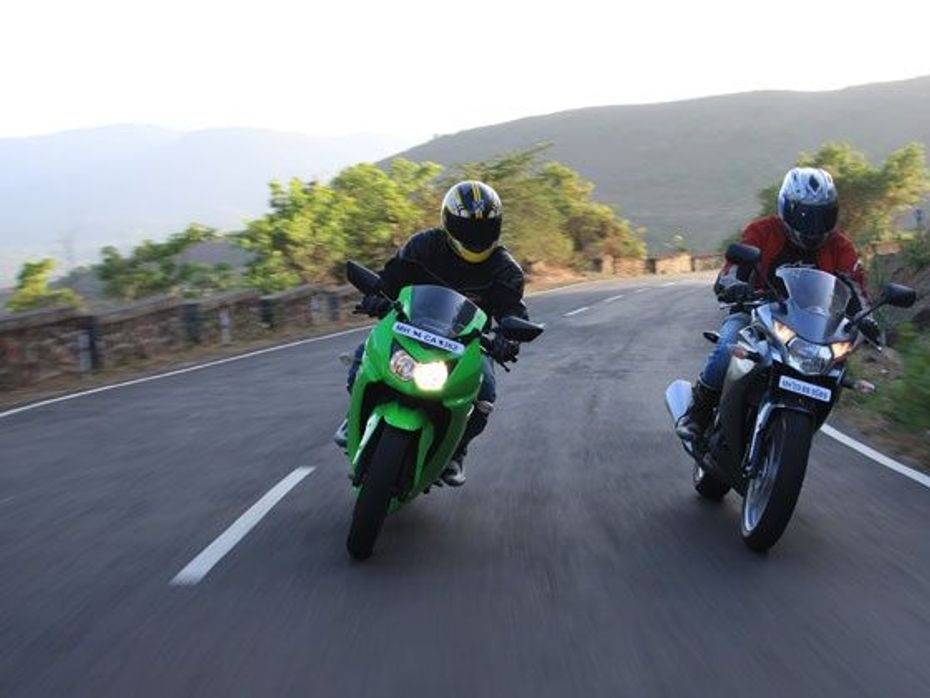
Round Three
We are into round three without either of the two motorcycles having lost their firm footing. That said, the longer wheel-based and heavier Ninja 250R definitely feels more composed and calm at speed than the CBR250R but it is the Kawasaki’s size and rather lavish proportions that hamper its ability to quickly turn directions especially when dealing with bumper-to-bumper traffic. On the other hand, the Honda CBR250R is a superbly versatile tool that feels compact and manageable for daily use and is extremely nimble to swiftly escape out of crowded city streets. However, the big-bike appeal or road presence that many buyers in this class would want after parting with a sizable amount of sum definitely comes from the Ninja and not the CBR.
The chassis and underpinnings on both these fully-faired machines are solidly built and have a sturdy feel to them. As robustly put together, the suspension setup on both the bikes is largely divergent resulting in very different ride experience astride each one of them. Tuned for the street and plush ride, the CBR’s rear suspension is a little too squishy and lacks the sprightly handling especially when attacking sweeping fast corners. This is where the Ninja’s expertise of all these years in the 250cc segment outclasses its rival, the CBR. Just the right suspension configuration for the street – neither too stiff to make it all bumpy nor too softly sprung to be wallowing around corners presenting the Ninja with near perfect dynamic ability for the street.

Round Four
The Ninja 250R’s experience does make a solid impact but the baby CBR does bring a lot to the table loaded with new age techno-wizardry. The most striking bit on the CBR being the Honda-patented Combined Anti-lock braking System (C-ABS) that makes the streets a much safer place for every rider aboard the CBR – young or old and newbie or expert alike. As expected then, the Honda did out-brake the Ninja, just about. In our 80-0 braking test, the CBR250R took 31.4 metres and 3.25 seconds to come to a halt. Although, I think with better rubber on the CBR than the OE-fitted Continental ContiGo tyres this time can be further dropped. However, the IRC tyres on the Ninja faired pretty well and braking performance on the five kilos heavier Ninja was not at all bad with the 290mm single petal disc upfront and a 220mm petal disc on the rear stopping the Kawasaki in 39.6metres and 3.5seconds.
Equipment wise the Honda clearly trumps the Ninja – fully digital console that is fresh and neatly done and comes with a clock. While the analogue dials on the Ninja are probably the most boring visuals on any modern-day sports motorcycle. Of course there is no clock on the Ninja! And then no pass switch either on the Kawasaki unlike the Honda but then the Ninja makes up with excellent headlight beam and spread, which is so crucial for our road conditions. Something lacking in the CBR’s fashionable and VFR1200F-ish inspired headlight design. The saddle is softer and cushier on the CBR as against the slightly hard feel of the Ninja’s seat but the pillion comfort is definitely more enhanced on the Ninja.

Round Five
Despite lack of features and equipment, the Kawasaki Ninja 250R feels much more robustly built than Honda’s CBR250R. The fit-and-finish on the Ninja is cleaner and pronounced than in the CBR. For instance, the side-stand on the CBR feels weak and lacks solid feel to it. The welding spots around the CBR’s frame look a bit sloppily done and very unlike the standards set by Honda. Both the bikes have more or less no under-seat storage space though one could cram some paperwork under the CBR’s pillion seat if he or she is so hell-bent. But there is really not much scope. And if you are still keen on carrying stuff on the motorcycle, both the bikes offer bungee hooks on the pillion footpegs albeit on the CBR there is no place to fix the remaining two hooks of a cargo net onto the rear. The Ninja on the other hand has two separate hooks under the rear tail panel once again showing the CBR how it’s to be done.
With modern day technology and advances in manufacturing processes, most motorcycles today are well-engineered and the two entries that we have here epitomize this reality like none other. I must admit then, picking one out of these two contenders has not been an easy task. Both, the Kawasaki and Honda are indeed closely matched nearly on all counts and the pricing of the Honda CBR250R almost brings a closure to the argument. Or does it?
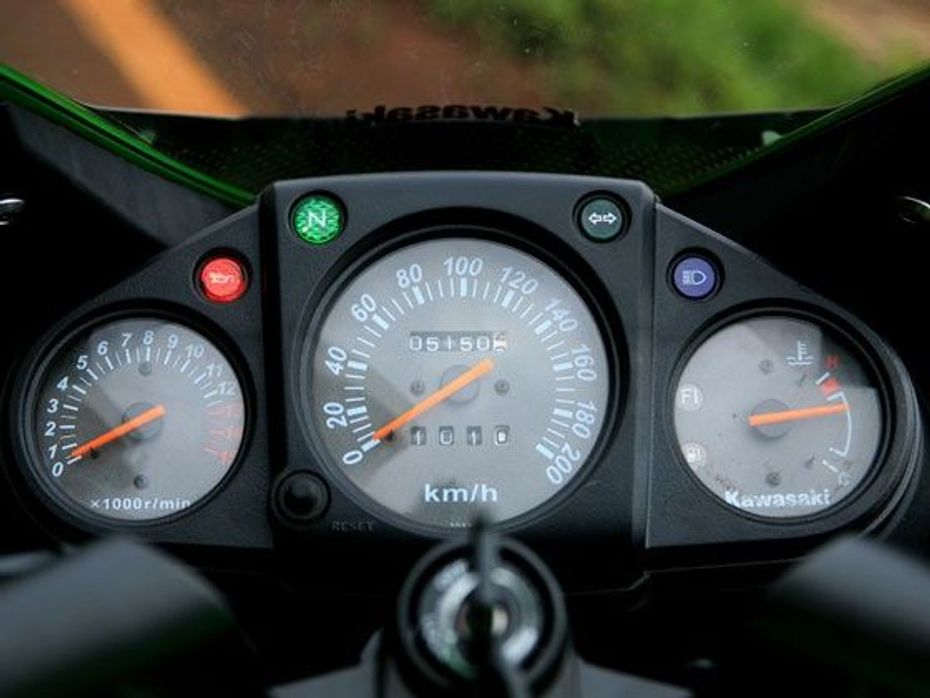
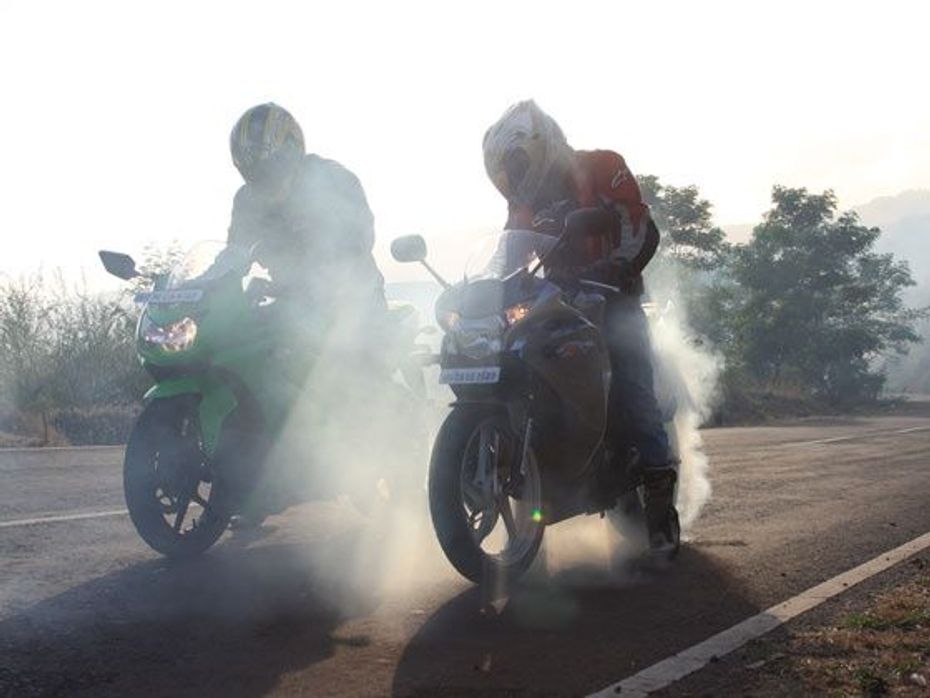
Winning Bell
So the Kawasaki Ninja 250R costing Rs. 2.69 lakh (ex-showroom, Delhi) is almost a lakh of rupees costlier than the Honda CBR250R with C-ABS costing Rs. 1.77 lakh (ex-showroom, Delhi) and it only fairs marginally higher than the CBR in most departments – it has better top-speed, slightly quicker performance and more comfort. But why is it that the Kawasaki is so expensive despite being marginally better in performance to the Honda? Firstly, let’s get one basic fact out of the way that the CBR is locally manufactured by Honda in India while the Ninja 250R is imported as a Completely Knocked Down kit (CKD) from Kawasaki’s manufacturing base in Thailand and assembled at Bajaj Auto’s Chakan plant near Pune.
Nevertheless, that’s not the only reason why the Kawasaki demands a premium. During our comparison test, it was instantly noticeable how much more road presence, and a decidedly sportier feel the Ninja 250R offered - clearly highlighting the ‘big-bike feel’ that everyone keeps harping about all the time. A true-blue sportsbike. Nothing less or nothing more than just an absolute thrill-machine that has the go to match the show. A high-revving parallel twin motor pumping out 33PS of power at staggering 11,000rpm yet offering oodles of comfort for riders of all shapes and sizes. Not scaring them but instead helping them learn the tricks of the motorcycling trade in a swift yet enjoyable manner. The Honda CBR250R is an excellent bang-for-the-buck machine but it tries too hard to beat the Ninja 250R, which does seem a bit over-priced in contrast to the CBR but is well worth every penny spent. All it takes is just swinging a leg over the two machines back-to-back and the difference between the CBR250R’s ‘just about there’ appeal and the Ninja 250R’s ‘been-there-done-that’ aura is pressing. Our pick out of the two then is the old-hand Kawasaki which still excels at everything one would expect from a quarter-litre sportsbike. The legend of the Ninja lives on.


Honda CBR250R vs KTM Duke 200 vs Bajaj Pulsar 200NS: Comparison

Honda CBR250R vs Kawasaki Ninja 250R : In Comparison

Quick comparo: Honda CBR250R vs Yamaha YZF-R15

Updated Honda CBR250R Showcased At Auto Expo 2018

MMRT Gears Up For Round 2 Of MMSC FMSCI National Racing Championship

Track Experience Aboard A Honda CBR150R One Make Race Bike

Race Report: MRF MMSC FMSCI Indian National Racing Championship Round...

Honda Secures 7 Podiums At The 2017 Indian National Motorcycle...

Sarath Kumar & Rajiv Sethu Off To Promising Starts

Honda Launches ‘Repsol Honda Racing Replica Limited Edition’ Of...
 Mahindra Scorpio N
Mahindra Scorpio N
 Royal Enfield Classic 350
Royal Enfield Classic 350
 Royal Enfield Hunter 350
Royal Enfield Hunter 350
 Toyota Fortuner
Toyota Fortuner
 Hyundai Creta
Hyundai Creta
India's largest automotive community
 Maruti Brezza
Rs. 8.34 Lakh
Maruti Brezza
Rs. 8.34 Lakh
 Maruti FRONX
Rs. 7.51 Lakh
Maruti FRONX
Rs. 7.51 Lakh
 Maruti Grand Vitara
Rs. 10.99 Lakh
Maruti Grand Vitara
Rs. 10.99 Lakh
 Mahindra Scorpio
Rs. 13.61 Lakh
Mahindra Scorpio
Rs. 13.61 Lakh
 Toyota Innova Crysta
Rs. 19.99 Lakh
Toyota Innova Crysta
Rs. 19.99 Lakh